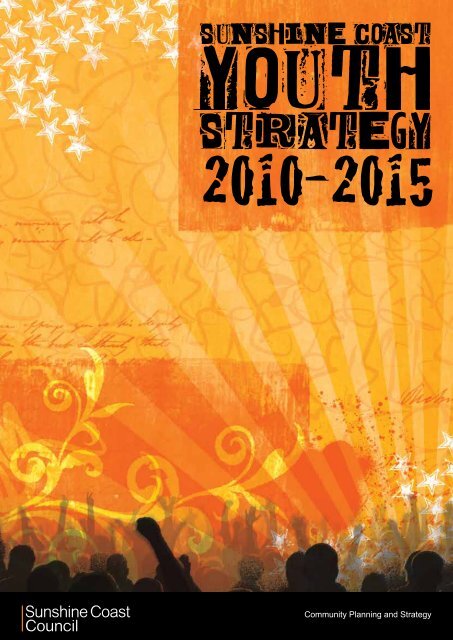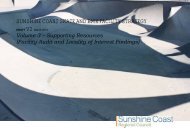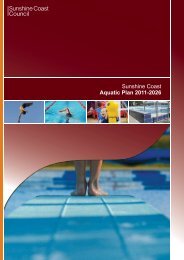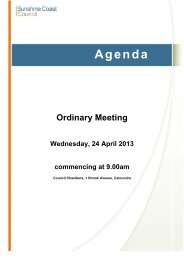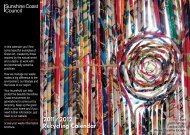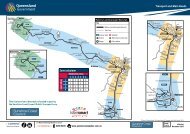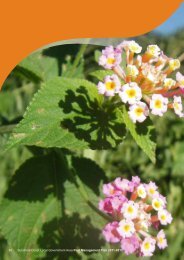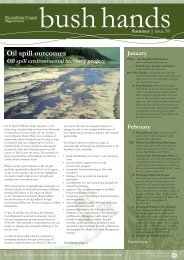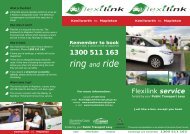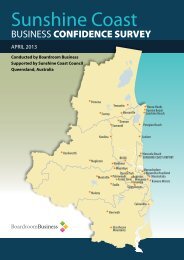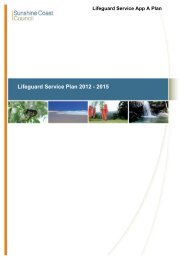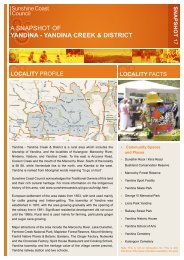Community Planning and Strategy - Sunshine Coast Council
Community Planning and Strategy - Sunshine Coast Council
Community Planning and Strategy - Sunshine Coast Council
Create successful ePaper yourself
Turn your PDF publications into a flip-book with our unique Google optimized e-Paper software.
<strong>Community</strong> <strong>Planning</strong> <strong>and</strong> <strong>Strategy</strong>
Foreword<br />
The <strong>Sunshine</strong> <strong>Coast</strong> Youth <strong>Strategy</strong> will deliver a partnership approach towards building a<br />
brighter future for young people on the <strong>Sunshine</strong> <strong>Coast</strong> over the next 5 years <strong>and</strong> beyond. The<br />
stakeholders include layers of government, non-government agencies, the community <strong>and</strong> of<br />
course, the young people who make up the vibrant heart of our region.<br />
The youth strategy delves into the issues that have a direct impact on the lives of young people<br />
whilst also defining <strong>Sunshine</strong> <strong>Coast</strong> <strong>Council</strong>’s commitments to building a strong <strong>and</strong> resilient<br />
youth population.<br />
The Speak Up Engage Program has been a key part of the strategy development, providing<br />
significant input from the young people of the region. The program has positioned young people<br />
as the experts of their own cultures, experiences <strong>and</strong> needs, <strong>and</strong> recognises that young people<br />
are aware of what works <strong>and</strong> what doesn’t in their communities.<br />
Our young people are the key to the future, <strong>and</strong> so it is imperative that council tap into their<br />
optimism, creativity, innovation <strong>and</strong> energy. Involving young people in local government<br />
decision-making processes ensures the organisation puts a direct focus on the need to<br />
generate “on the ground” outcomes that are ultimately motivated by the aspirations of young<br />
people.<br />
The implementation of the <strong>Sunshine</strong> <strong>Coast</strong> Youth <strong>Strategy</strong> will draw upon <strong>and</strong> strengthen the<br />
links between council, young people <strong>and</strong> the community. It is important to develop a youth<br />
strategy that will facilitate greater outcomes for our young people through a collaborative<br />
approach to youth services.<br />
Through the strategy, council is aspiring to create an environment where young people are<br />
included in the decisions that have an impact on their lives. Encouraging partnerships with<br />
our young people promotes mutual respect <strong>and</strong> provides opportunities for young people to<br />
participate in civic life <strong>and</strong> take pride in their region.<br />
Cr Bob Abbot<br />
MAYOR<br />
Cr Christian Dickson<br />
COMMUNITY ENGAGEMENT<br />
AND GOVERNANCE PORTFOLIO
Table of Contents<br />
Executive Summary 05<br />
Benefits of the Youth <strong>Strategy</strong> for our Region 06<br />
<strong>Sunshine</strong> <strong>Coast</strong> Youth <strong>Strategy</strong> 2010 - 2015 07<br />
Young People on the <strong>Sunshine</strong> <strong>Coast</strong> - a Snapshot 08<br />
What Underpins the <strong>Sunshine</strong> <strong>Coast</strong> Youth <strong>Strategy</strong>? 10<br />
<strong>Council</strong>’s Current Commitment 12<br />
Principle 1: Youth Voice <strong>and</strong> Action 14<br />
Principle 2: Access <strong>and</strong> Opportunity for all 15<br />
Principle 3: Speaking up for Youth 16<br />
Principle 4: Working Together 17<br />
Principle 5: Youth <strong>and</strong> <strong>Community</strong> Connections 18<br />
Appendix A - Consultation with the Youth Sector 20<br />
Appendix B - Relevant Documents 21<br />
Appendix C - Glossary 22<br />
Action Plan 23<br />
Findings from the Sunny <strong>Coast</strong> Youth Survey Fact Sheet 31<br />
04<br />
For further information, please contact:<br />
Youth Development Officer<br />
<strong>Sunshine</strong> <strong>Coast</strong> Regional <strong>Council</strong><br />
e: commpartnerships@sunshinecoast.qld.gov.au<br />
p: (07) 5475 7272
EXECUTIVE SUMMARY<br />
The <strong>Sunshine</strong> <strong>Coast</strong> Youth <strong>Strategy</strong> has been developed with input from the region’s young people,<br />
youth sector <strong>and</strong> many areas across council, to ensure that youth needs, issues <strong>and</strong> aspirations are<br />
embedded into existing <strong>and</strong> future functions, facilities, services <strong>and</strong> resources of council.<br />
On the <strong>Sunshine</strong> <strong>Coast</strong>, young people contribute to the vibrancy <strong>and</strong> prosperity of local<br />
communities. This strategy helps to achieve council’s vision to become a vibrant, green <strong>and</strong> diverse<br />
region. The strategy identifies young people as those aged 11-24 years which represents 17% of<br />
the population. Within this broad age grouping, three smaller cohorts have been identified: 11-14<br />
years, 15-19 years <strong>and</strong> 20-24 years.<br />
The Speak Up Engage Program has been an important component of the formation of the<br />
foundation paper, Young People on the <strong>Sunshine</strong> <strong>Coast</strong> <strong>and</strong> the development of the youth strategy.<br />
The main aim of the program was to inform the development of council’s Youth Engagement<br />
Framework that would guide council on how to better involve young people in local government<br />
decision-making processes <strong>and</strong> enhance future engagement practices. These practices provide<br />
young people with the opportunity to participate in a mutual partnership with council <strong>and</strong> to build this<br />
region.<br />
One of the main outcomes of the Speak Up Engage Program was the Sunny <strong>Coast</strong> Youth Survey<br />
2010. The Speak up Engage Program engaged with over 2300 young people across the region to<br />
determine what young people like about their local areas, the key issues for young people <strong>and</strong> their<br />
visions for the next ten years.<br />
The survey revealed that the majority of young people value a sense of community, the environment<br />
<strong>and</strong> living in a convenient location. The key issues that impact their lives are drugs <strong>and</strong> alcohol,<br />
crime <strong>and</strong> a lack of arts <strong>and</strong> cultural activities. In ten years time, young people would like to see a<br />
region that has a greater sense of community, where population <strong>and</strong> growth are monitored <strong>and</strong> the<br />
environment is protected <strong>and</strong> preserved.<br />
The guiding principles <strong>and</strong> associated commitments of the <strong>Sunshine</strong> <strong>Coast</strong> Youth <strong>Strategy</strong> were<br />
developed from the Speak Up Engage Program <strong>and</strong> the outcomes of the Sunny <strong>Coast</strong> Youth Survey<br />
2010. The guiding principles are:<br />
»»<br />
Youth voice <strong>and</strong> action<br />
»»<br />
Access <strong>and</strong> opportunity for all<br />
»»<br />
Speaking up for youth<br />
»»<br />
Working together<br />
»»<br />
Youth <strong>and</strong> community connections<br />
The action plan is based on the principles <strong>and</strong> commitments <strong>and</strong> has been developed from an<br />
holistic organisational perspective.<br />
05
Benefits of the Youth <strong>Strategy</strong> for our region<br />
The <strong>Sunshine</strong> <strong>Coast</strong> Youth <strong>Strategy</strong> 2010-2015 has been developed with input from the region’s<br />
young people, youth sector <strong>and</strong> many areas across council to ensure that youth needs, issues <strong>and</strong><br />
aspirations are embedded into existing <strong>and</strong> future functions, facilities, services <strong>and</strong> resources of<br />
council.<br />
<strong>Council</strong> is committed to continue to work in partnership with all levels of government, nongovernment<br />
agencies, the community <strong>and</strong> young people to build a resilient youth population <strong>and</strong> to<br />
provide opportunities for them to reach their full potential.<br />
Working closely with the community <strong>and</strong> across the whole region, council aims to achieve<br />
maximum outcomes with minimum intervention. <strong>Council</strong> will always look to develop capacity within<br />
the community to respond to issues before considering direct service delivery.<br />
The youth strategy has a strong emphasis on meaningful <strong>and</strong> ongoing engagement, <strong>and</strong> provides<br />
a vehicle for young people to voice their concerns <strong>and</strong> influence council decisions. Encouraging<br />
partnerships with our young people promotes mutual respect <strong>and</strong> provides opportunities for them<br />
to participate in civic life <strong>and</strong> contribute to this region. The benefits of this partnership approach to<br />
the youth strategy include:<br />
Benefits for council<br />
<strong>Council</strong> will benefit through having a strategic direction that taps into the creativity <strong>and</strong><br />
resources, energy <strong>and</strong> enthusiasm of young people. In a changing environment, young people<br />
hold the key to the future. <strong>Council</strong> is committed to providing young people with the opportunity<br />
to participate in a mutual partnership to build this region. Engaging <strong>and</strong> involving young people<br />
in local government exposes the organisation to youthful optimism <strong>and</strong> innovative ideas whilst<br />
creating deeper roots <strong>and</strong> stronger loyalties amongst its younger citizens.<br />
Benefits for young people<br />
<strong>Council</strong> aims to work with young people to develop their full potential <strong>and</strong> enhance their<br />
wellbeing through the outcomes of the youth strategy <strong>and</strong> Speak Up Engage Program. This<br />
enables council to facilitate youth development. Essentially, youth engagement provides young<br />
people with a platform to enhance their skills, build their competencies, <strong>and</strong> contribute to local<br />
government decision-making <strong>and</strong> ultimately assist in the development of policies, programs<br />
<strong>and</strong> services. Greater participation by young people in civic life creates a sense of belonging,<br />
ownership <strong>and</strong> pride in their local community <strong>and</strong> across the region. This in turn leads to<br />
aiding in the retention of young people in the region <strong>and</strong> the future wellbeing <strong>and</strong> strength of<br />
communities.<br />
06<br />
Benefits for the community<br />
Through youth engagement <strong>and</strong> outcomes of the strategy, the community will have a better<br />
underst<strong>and</strong>ing <strong>and</strong> acknowledgement of young people’s rights as citizens <strong>and</strong> their contributions<br />
to the economy, culture <strong>and</strong> vibrancy of the community. Organisations <strong>and</strong> institutions that<br />
facilitate intergenerational involvement <strong>and</strong> recognise young people as fully contributing<br />
members of a democratic society are themselves contributing to a progressive dialogue on<br />
youth <strong>and</strong> social change. Additionally, gathering <strong>and</strong> sharing of information promotes <strong>and</strong><br />
enables good decision-making, clarifies <strong>and</strong> informs issues <strong>and</strong> allows accurate allocation of<br />
resources.
<strong>Sunshine</strong> <strong>Coast</strong> Youth <strong>Strategy</strong> 2010 - 2015<br />
The guiding principles of the <strong>Sunshine</strong> <strong>Coast</strong> Youth <strong>Strategy</strong> are:<br />
Youth voice <strong>and</strong> action<br />
Communicate effectively with young people, their families <strong>and</strong> others in their lives to build <strong>and</strong><br />
facilitate services <strong>and</strong> outcomes that are responsive <strong>and</strong> flexible in meeting their needs.<br />
Access <strong>and</strong> opportunity for all<br />
Promote the equitable distribution <strong>and</strong> accessibility of resources, services <strong>and</strong> facilities to be<br />
inclusive of diversity such as age, gender, sexuality, cultural background, language, ability or<br />
geographical location.<br />
Speaking up for youth<br />
Listen to <strong>and</strong> acknowledge the needs <strong>and</strong> issues of the <strong>Sunshine</strong> <strong>Coast</strong>’s diverse youth population.<br />
Advocate to other levels of government, the commercial <strong>and</strong> community sectors for resources <strong>and</strong><br />
support.<br />
Working together<br />
Build collaborative partnerships with the youth sector, agencies <strong>and</strong> young people to support<br />
the development of programs that increase their capacity through personal development, skills,<br />
knowledge <strong>and</strong> learning.<br />
Youth <strong>and</strong> community connections<br />
Build the resilience of young people by creating a sense of belonging <strong>and</strong> a sense of place that<br />
encourages community participation, active citizenship <strong>and</strong> volunteering.<br />
These five principles have been adapted from nine good practice principles identified <strong>and</strong><br />
endorsed by the young participants in the Speak Up Engage Program. These same good practice<br />
principles have been an integral part of youth work <strong>and</strong> service delivery in local government for<br />
over 15 years on the <strong>Sunshine</strong> <strong>Coast</strong>.<br />
In embracing these guiding principles <strong>and</strong> in line with council’s Corporate Plan 2009-2014,<br />
council’s role in the youth sector will include:<br />
»»<br />
building capacity <strong>and</strong> partnerships through creative programs <strong>and</strong> development initiatives<br />
»»<br />
promoting safety, accessibility <strong>and</strong> inclusiveness<br />
»»<br />
advocating for resources <strong>and</strong> support for young people within the region, <strong>and</strong><br />
»»<br />
facilitating communication, information sharing, networking <strong>and</strong> active citizenship.<br />
07
Young People on the <strong>Sunshine</strong> <strong>Coast</strong> - A snapshot<br />
The foundation paper, Young People on the <strong>Sunshine</strong> <strong>Coast</strong>, provides a detailed demographic<br />
analysis of the region’s youth population <strong>and</strong> explores issues that impact their lives.<br />
On the <strong>Sunshine</strong> <strong>Coast</strong>, young people contribute to the vibrancy <strong>and</strong> prosperity of local<br />
communities <strong>and</strong> this vibrant, green <strong>and</strong> diverse region. Young people are those aged 11-24 years.<br />
Within this broad age grouping, three smaller age cohorts have been defined in line with the Office<br />
of Youth Affairs: 11-14 years, 15-19 years <strong>and</strong> 20-24 years.<br />
<strong>Sunshine</strong> <strong>Coast</strong><br />
Queensl<strong>and</strong><br />
Young people 11–24 years 17.4% 19.7%<br />
Young people 11–14 years 5.8% 5.8%<br />
Young people 15–19 years 6.5% 7.0%<br />
Young people 20–24 years 5.0% 6.9%<br />
Indigenous 11–24 year olds<br />
(as proportion of youth population)<br />
2.2% 5.4%<br />
Young people studying (full <strong>and</strong> part time) 67.8% 83.3%<br />
Young people living in family households 54.3% 60.9%<br />
Young people 15–24 years in workforce<br />
Employed in retail industry<br />
Employed in hospitality industry<br />
Employed in construction industry<br />
26.3%<br />
19.7%<br />
12.3%<br />
19.0%<br />
5.9%<br />
5.2%<br />
Young people employed part time 43.0% 46.5%<br />
Young people employed full time 41.1% 38.3%<br />
ABS 2006<br />
08<br />
Australian Bureau of Statistics Census Data 2006 indicate that the majority of employed 15-24 year<br />
olds within the region worked in the retail industry (26.3%), followed by accommodation <strong>and</strong> food<br />
services (19.7%) <strong>and</strong> construction (12.3%). This reflects the region’s historic economic base <strong>and</strong><br />
employment opportunities; however recent employment data shows a significant change in this<br />
historic pattern. In 2009, employment in the retail sector almost doubled while in the construction<br />
sector it decreased by almost 50% (Education Queensl<strong>and</strong> 2009, Year 12 Completers Survey).
What underpins the <strong>Sunshine</strong> <strong>Coast</strong> Youth <strong>Strategy</strong>?<br />
<strong>Council</strong>’s Youth Engagement Program – Speak up Engage<br />
The Speak Up Engage Program has been an important component in the formation of the<br />
foundation paper, Young People on the <strong>Sunshine</strong> <strong>Coast</strong>, <strong>and</strong> the development of the youth<br />
strategy. The main aim of the program was:<br />
»»<br />
to inform the development of council’s youth engagement model that would guide council<br />
on how to better involve young people in local government decision-making processes <strong>and</strong><br />
enhance future engagement practices.<br />
The Speak Up Engage Youth Team is a group of young people working with council since<br />
2008, primarily concerned with the overarching issue of youth engagement <strong>and</strong> the methods<br />
of engagement that would be most effective to encourage young people’s participation in local<br />
government decision-making. Using identified themes, the team tested the effectiveness of a<br />
number of engagement tools including face-to-face interviews, online surveys <strong>and</strong> blogs, <strong>and</strong><br />
use of the media. From these learnings, a model for youth engagement emerged. The youth<br />
engagement model recognises that young people are the experts in engaging with their peers<br />
<strong>and</strong> promotes the use of a variety of engagement techniques (face-to-face interviews <strong>and</strong><br />
electronic media) which will maximise youth participation. The final outcome was the action based<br />
application of the model with the development of a youth survey administered by young people in<br />
the 44 localities of the <strong>Sunshine</strong> <strong>Coast</strong> region. This resulted in 2,307 respondents, representing<br />
approximately 5% of the youth population aged 11-25 years. The success <strong>and</strong> robustness of the<br />
Sunny <strong>Coast</strong> Youth Survey validates the effectiveness of the youth engagement model.<br />
Vision for young people in the region<br />
Through the Speak Up Engage Program - Sunny <strong>Coast</strong> Youth Survey 2010, young people were<br />
given the opportunity to express their hopes <strong>and</strong> aspirations for the <strong>Sunshine</strong> <strong>Coast</strong> over the next<br />
ten years. The following table provides the three open ended questions, top three themes for each<br />
<strong>and</strong> number of responses.<br />
Open ended questions Top themes as identified by young people<br />
What do you like about your suburb/local area? Sense of community – 1,323<br />
Environment – 1,087<br />
Convenient location - 726<br />
What are the biggest issues for young people<br />
living on the <strong>Sunshine</strong> <strong>Coast</strong>?<br />
What do you want the <strong>Sunshine</strong> <strong>Coast</strong> to look<br />
like in 10 years time?<br />
Drugs <strong>and</strong> alcohol – 815<br />
Crime – 488<br />
Lack of arts <strong>and</strong> cultural activities - 445<br />
Sense of community – 1,129<br />
Population <strong>and</strong> growth – 813<br />
Environment – 603<br />
10<br />
• More information about the results of the Sunny <strong>Coast</strong> Youth Survey 2010 can be found on<br />
the Findings from the Sunny <strong>Coast</strong> Youth Survey Fact Sheet (see attached).<br />
• For issues identified by the youth sector, refer to Appendix A.
The survey found that young people have a vision for the future of the <strong>Sunshine</strong> <strong>Coast</strong> where<br />
communities are more vibrant, harmonious <strong>and</strong> friendly. Where they can travel the coast with ease<br />
<strong>and</strong> safety <strong>and</strong> access more youth friendly entertainment <strong>and</strong> activities. A region that is prosperous<br />
<strong>and</strong> offers a variety of education <strong>and</strong> employment opportunities for young people, manages<br />
population growth <strong>and</strong> development while protecting the environment.<br />
Working with the <strong>Community</strong><br />
The youth strategy has been developed by working closely with the region’s youth sector. <strong>Council</strong><br />
will aim to develop capacity within the community to respond to youth needs <strong>and</strong> to facilitate<br />
a coordinated approach to youth services across the region. There are many benefits to this<br />
approach including:<br />
»»<br />
building capacity in local organisations<br />
»»<br />
creating an environment of collaboration between stakeholders<br />
»»<br />
engendering ownership of issues <strong>and</strong> solutions by the community<br />
»»<br />
creating a bigger pool of expertise to consider issues <strong>and</strong> responses, <strong>and</strong><br />
»»<br />
increasing advocacy power to other levels of government due to collaborative, region-wide<br />
responses.<br />
Most significantly, this approach works towards creating a stronger, more resilient <strong>and</strong> sustainable<br />
community.<br />
Working with the Youth Sector<br />
Consultation with the youth sector has been an important element in the development of the youth<br />
strategy. A meeting with the youth sector took place on 1 June 2010 <strong>and</strong> highlighted the issues<br />
found on page 20. This meeting was scheduled in response to requests that emerged at the<br />
<strong>Community</strong> Services Conference held in May for more involvement with council.<br />
In an effort to validate these issues, an online survey to the broader youth sector was conducted<br />
in July. The survey was sent to 52 youth-focused organisations from across the region <strong>and</strong> 18<br />
responses were received.<br />
According to responses received, council’s role within the sector might be a combination of<br />
coordination, communication <strong>and</strong> engagement, sector support <strong>and</strong> capacity building, funding <strong>and</strong><br />
providing youth activities <strong>and</strong> events.<br />
Foundation Paper to <strong>Council</strong>’s <strong>Strategy</strong><br />
The foundation paper, Young People on the <strong>Sunshine</strong> <strong>Coast</strong>, was a preliminary step in the creation<br />
of the youth strategy. The background paper is extensive in its coverage of young people <strong>and</strong><br />
the multiple issues that impact their lives. The methodology for compiling the paper included<br />
various information sources at a local, state <strong>and</strong> national level. The paper incorporates previous<br />
consultation, research <strong>and</strong> social <strong>and</strong> youth policies from the three former local governments of<br />
the <strong>Sunshine</strong> <strong>Coast</strong>. The paper also incorporates data from the Speak Up Engage Program (2008<br />
– 2010) <strong>and</strong> data from the <strong>Sunshine</strong> <strong>Coast</strong> Youth Partnership youth survey <strong>and</strong> summit (2009). To<br />
view the foundation paper, Young People on the <strong>Sunshine</strong> <strong>Coast</strong>, visit council’s website.<br />
11
<strong>Council</strong>’s Current Commitment<br />
<strong>Council</strong>’s commitment to the community, including young people, is articulated in the Corporate<br />
Plan 2009-2014 under the theme of Social Cohesion:<br />
“Strong communities provide lifestyle choices, share ideas, provide mutual support, <strong>and</strong> celebrate<br />
their local identity <strong>and</strong> culture. Relationships between governments, community <strong>and</strong> business<br />
sectors build trust <strong>and</strong> encourage sharing of ideas <strong>and</strong> resources. Through its social planning<br />
strategies <strong>and</strong> programs, council will help develop a sense of identity <strong>and</strong> belonging, promote <strong>and</strong><br />
encourage interactions, ensure equal opportunities <strong>and</strong> provide information to help strengthen<br />
community groups <strong>and</strong> networks.”<br />
<strong>Council</strong>’s commitment to young people is reflected in its services, facilities <strong>and</strong> functions <strong>and</strong><br />
includes:<br />
»»<br />
advocating for the needs of young people in the community <strong>and</strong> within council<br />
»»<br />
breaking down barriers to participation <strong>and</strong> engaging with council by creating opportunities for<br />
young people to participate in development activities <strong>and</strong> contribute to council decision-making<br />
processes<br />
»»<br />
celebrating the diversity of young people <strong>and</strong> recognising their individuality<br />
»»<br />
providing equitable access to services, facilities <strong>and</strong> information<br />
»»<br />
enhancing the wellbeing of young people <strong>and</strong> their families by providing information <strong>and</strong> referral<br />
to programs that are responsive to their needs<br />
»»<br />
facilitating development opportunities that empower young people<br />
»»<br />
providing <strong>and</strong> maintaining community, recreation <strong>and</strong> sporting facilities<br />
»»<br />
promoting opportunities to participate in recreational, sporting, cultural <strong>and</strong> artistic activities<br />
»»<br />
promoting participation of young people in their communities<br />
»»<br />
providing leadership in planning, collaboration <strong>and</strong> partnerships across youth service networks<br />
<strong>and</strong> with other community providers at the local, regional <strong>and</strong> state levels<br />
»»<br />
providing opportunities to celebrate the value <strong>and</strong> strengths of young people<br />
»»<br />
supporting <strong>and</strong> developing leadership in young people, <strong>and</strong><br />
»»<br />
supporting young people to be advocates at a local, regional, state <strong>and</strong> federal level.<br />
The <strong>Sunshine</strong> <strong>Coast</strong> Youth <strong>Strategy</strong> is inclusive of all cultures. <strong>Council</strong> also acknowledges<br />
Aboriginal <strong>and</strong> Torres Strait Isl<strong>and</strong>ers as first Australians <strong>and</strong> its commitment to reconciliation<br />
through the Reconciliation Action Plan.<br />
12
These commitments are enacted through council initiatives which include, but are not limited to:<br />
»»<br />
Externally Funded/Partnership<br />
Programs<br />
* Speak Up Engage<br />
* Black Swans Big Day Out<br />
* TravelSmart<br />
* Holiday programs<br />
* Living Smart<br />
* AMPED - <strong>Sunshine</strong> <strong>Coast</strong> A-Venue<br />
Program<br />
* Smart Arts<br />
»»<br />
Strategies/Policies/Plans<br />
* Youth Arts <strong>Strategy</strong><br />
* Skate <strong>and</strong> BMX <strong>Strategy</strong><br />
* Economic Development <strong>Strategy</strong><br />
* Cultural Plan<br />
* Open Space <strong>Strategy</strong><br />
»»<br />
Internal Programs<br />
* Environmental education<br />
* Grants<br />
* Education resources (libraries)<br />
* Information <strong>and</strong> literacy sessions<br />
* Healthy education programs<br />
* Street performance<br />
* <strong>Community</strong> safety<br />
»»<br />
Infrastructure<br />
* Cultural infrastructure<br />
* Sporting <strong>and</strong> recreation facilities<br />
* <strong>Community</strong> centres/halls<br />
* Cycleways <strong>and</strong> footpaths<br />
* Aquatic centres<br />
13
Principle 1: Youth voice <strong>and</strong> action<br />
OBJECTIVE: Communicate effectively with young people, their families <strong>and</strong> others in<br />
their lives to build <strong>and</strong> facilitate services <strong>and</strong> outcomes that are responsive <strong>and</strong> flexible<br />
in meeting their needs.<br />
Investing in young people is investing in the future of the <strong>Sunshine</strong> <strong>Coast</strong>. Facilitating opportunities<br />
for young people to participate in community life acknowledges that they are valued members<br />
of their community. Initiatives such as the Speak Up Engage Program allow young people to<br />
participate in an engagement process <strong>and</strong> express their opinions on matters that concern them in<br />
innovative <strong>and</strong> appealing ways.<br />
Research conducted with <strong>and</strong> for young people suggests that they differ from older generations in<br />
their preferred method of engagement in the political process. ‘There is clear evidence that young<br />
people in Australia are engaged with political <strong>and</strong> social issues, but that they feel alienated by<br />
formal, institutionalised politics <strong>and</strong> are less inclined to engage in traditional forms of participation’<br />
(Collin 2008:20).<br />
Research also suggests that young people value processes <strong>and</strong> experiences that are fun,<br />
culturally relevant, flexible, <strong>and</strong> effective. It is these aspects that the Speak Up Engage Youth Team<br />
exploited in developing the model of engagement for council <strong>and</strong> in administering the Sunny <strong>Coast</strong><br />
Youth Survey 2010.<br />
The Sunny <strong>Coast</strong> Youth Survey 2010 engaged with 2,307 young people between the ages of<br />
11 <strong>and</strong> 25 years across the <strong>Sunshine</strong> <strong>Coast</strong>. This represents 4.6% of the youth population <strong>and</strong><br />
demonstrates that young people are willing to participate <strong>and</strong> offer their opinions on matters that<br />
affect them <strong>and</strong> the community. The survey utilised four main engagement methods; media,<br />
marketing <strong>and</strong> promotion, interpersonal <strong>and</strong> online engagement.<br />
Through this process, respondents expressed strong views on a variety of themes including:<br />
Sense of <strong>Community</strong>; Environment; Population <strong>and</strong> Growth; Transport; Crime; Drugs <strong>and</strong> Alcohol;<br />
Employment; <strong>and</strong> <strong>Community</strong> Safety. Young people have also expressed a desire to seek out <strong>and</strong><br />
avail themselves of opportunities to be involved in council <strong>and</strong> community decision-making <strong>and</strong> to<br />
break away from the negative stereotypes <strong>and</strong> perceptions portrayed in the media.<br />
“We need people who really underst<strong>and</strong> teens, who want to give us<br />
opportunities.”<br />
youth<br />
voice<br />
<strong>Council</strong>’s commitments in relation to this principle include:<br />
»»<br />
facilitating opportunities for young people to be heard <strong>and</strong> valuing their views <strong>and</strong><br />
opinions<br />
»»<br />
engaging meaningfully with young people <strong>and</strong> enabling them to have a say in<br />
decisions that affect their lives<br />
»»<br />
adopting innovative <strong>and</strong> appropriate methods of communication that are relevant<br />
<strong>and</strong> appealing to young people.<br />
14
Principle 2: Access <strong>and</strong> opportunities for all<br />
OBJECTIVE: Promote the equitable distribution <strong>and</strong> accessibility of resources, services<br />
<strong>and</strong> facilities to be inclusive of diversity such as age, gender, sexuality, cultural<br />
background, language, ability or geographical location.<br />
Young people are often disadvantaged due to a lack of equitable access to resources <strong>and</strong><br />
opportunities. One of the key issues for young people on the <strong>Sunshine</strong> <strong>Coast</strong> is travelling from<br />
place to place in this vast region. The ability to utilise different modes of transport is important<br />
for young people to develop a sense of independence, to access employment, education,<br />
entertainment, activities <strong>and</strong> to “hang out” with friends. The dispersed nature of the <strong>Sunshine</strong><br />
<strong>Coast</strong> creates difficulties in accessing public transport that is convenient, affordable <strong>and</strong> timely.<br />
This leads to a heavy reliance on parents <strong>and</strong> private vehicles for transport which further inhibits<br />
independence. Cycleways <strong>and</strong> pathways offer alternative forms of mobility (cycling, walking <strong>and</strong><br />
skateboarding) for young people <strong>and</strong> promote physical activity.<br />
For a variety of reasons, many young people have disconnected or are at risk of disconnecting<br />
from formal education. Access to flexible alternative education <strong>and</strong> training programs is essential<br />
to help these young people reach their full potential. Programs such as the Federally funded<br />
Youth Connections <strong>and</strong> the State funded Youth Support Coordinator Program are geared towards<br />
reconnecting young people in innovative ways <strong>and</strong> providing alternatives to mainstream education.<br />
The Sunny <strong>Coast</strong> Youth Survey highlighted young people’s need for opportunities <strong>and</strong> places for<br />
hanging out <strong>and</strong> social interaction. Comments around this theme related to not enough to do or<br />
not enough age appropriate activities or places, <strong>and</strong> the cost <strong>and</strong> ability to access such places<br />
<strong>and</strong> activities. In addition to these unstructured pursuits, young people surveyed expressed a<br />
desire for greater access to youth entertainment <strong>and</strong> events, transport <strong>and</strong> recreational activities<br />
(sporting <strong>and</strong> physical activities). Young respondents to the survey also expressed the need for<br />
greater access to casual <strong>and</strong> part-time employment opportunities for students as well as the need<br />
for a diversity of industries on the <strong>Sunshine</strong> <strong>Coast</strong>. These needs were exacerbated by the lack of<br />
affordable accommodation <strong>and</strong> a convenient <strong>and</strong> timely transport system.<br />
Access to information empowers young people to actively participate in the community. Web based<br />
media <strong>and</strong> social networking sites are used extensively by young people to connect with others<br />
<strong>and</strong> to discover what is happening on the <strong>Sunshine</strong> <strong>Coast</strong> <strong>and</strong> in their local communities.<br />
“With limited bus times <strong>and</strong> routes it is hard to reach certain<br />
destinations on certain days.”<br />
youth<br />
voice<br />
<strong>Council</strong>’s commitments in relation to this principle include:<br />
»»<br />
advocate for improved services <strong>and</strong> infrastructure for the whole region<br />
»»<br />
facilitate information sharing<br />
»»<br />
build partnerships with the commercial <strong>and</strong> community sectors to provide more<br />
opportunities <strong>and</strong> resources for young people.<br />
15
Principle 3: Speaking up for youth<br />
OBJECTIVE: Listen to <strong>and</strong> acknowledge the needs <strong>and</strong> issues of the <strong>Sunshine</strong> <strong>Coast</strong>’s<br />
diverse youth population. Advocate to other levels of government, the commercial <strong>and</strong><br />
community sectors for resources <strong>and</strong> support.<br />
Many of the issues that impact on the lives of the <strong>Sunshine</strong> <strong>Coast</strong>’s young people are outside the<br />
jurisdiction of council; however council can play an active role in engaging with young people to<br />
underst<strong>and</strong> their concerns, needs <strong>and</strong> aspirations, <strong>and</strong> advocate on their behalf for resources <strong>and</strong><br />
support to bring about positive changes that will benefit the whole community.<br />
The issues that impact the lives of young people on the <strong>Sunshine</strong> <strong>Coast</strong> are many <strong>and</strong> varied<br />
<strong>and</strong> include mental <strong>and</strong> physical health concerns such as obesity, self-esteem, depression, <strong>and</strong><br />
drug <strong>and</strong> alcohol abuse. There are also issues associated with education, employment <strong>and</strong><br />
homelessness. Some of the most difficult periods for young people are times when they are<br />
transitioning from one life phase to another: from primary to secondary school; secondary to<br />
tertiary education or work; from childhood to adulthood. These are stressful times for young people<br />
<strong>and</strong> can place pressure on relationships <strong>and</strong> increase the risk to young people of homelessness,<br />
poor mental <strong>and</strong> emotional health, <strong>and</strong> drug <strong>and</strong> alcohol abuse.<br />
Some respondents to the Sunny <strong>Coast</strong> Youth Survey 2010 observed that there is easy access<br />
to drugs on the <strong>Sunshine</strong> <strong>Coast</strong> <strong>and</strong> that drug abuse is related to boredom <strong>and</strong> a lack of age<br />
appropriate activities, entertainment <strong>and</strong> suitable, affordable venues.<br />
Young people’s responses in the Sunny <strong>Coast</strong> Youth Survey indicate the need to address issues<br />
of access to efficient <strong>and</strong> convenient transportation, greater employment opportunities, <strong>and</strong> the<br />
availability of affordable housing <strong>and</strong> crisis accommodation.<br />
Their vision for the future of the <strong>Sunshine</strong> <strong>Coast</strong> is one where there is intergenerational harmony<br />
<strong>and</strong> respect; where there is increased availability of public transport, open space, recreational<br />
facilities <strong>and</strong> entertainment options, <strong>and</strong> a region that is economically <strong>and</strong> environmentally<br />
sustainable.<br />
“The community needs to give us a chance to prove ourselves<br />
so we can earn their trust!”<br />
youth<br />
voice<br />
<strong>Council</strong>’s commitments in relation to this principle include:<br />
»»<br />
empowering young people to speak up for themselves <strong>and</strong> to take a lead role in the<br />
planning, implementation <strong>and</strong> evaluation of activities <strong>and</strong> programs to increase the<br />
likelihood of achieving positive outcomes for young people <strong>and</strong> communities<br />
»»<br />
advocate with other levels of government, the commercial <strong>and</strong> community sectors to<br />
improve support <strong>and</strong> health service provision, <strong>and</strong><br />
»»<br />
strengthen intervention <strong>and</strong> support programs that assist young people with major<br />
transitions in their lives.<br />
16
Principle 4: Working together<br />
OBJECTIVE: Build collaborative partnerships with the youth sector, agencies <strong>and</strong> young<br />
people to support the development of programs that increase capacity through personal<br />
development, skills, knowledge <strong>and</strong> learning.<br />
Developing close working relationships with young people assists in building their capacity <strong>and</strong><br />
enables them to actively participate in community life as citizens in their own right. Assisting young<br />
people to build their skills <strong>and</strong> knowledge <strong>and</strong> become resilient, self sufficient <strong>and</strong> active citizens is<br />
of benefit to the whole community.<br />
The responsibility for the wellbeing of young people belongs to the whole community <strong>and</strong><br />
therefore requires a collaborative approach with other levels of government, the commercial <strong>and</strong><br />
community sectors <strong>and</strong> young people. A key component of working together is to identify the<br />
variety of services <strong>and</strong> programs that exist for young people at a local, district or regional level. The<br />
<strong>Sunshine</strong> <strong>Coast</strong> is well serviced by long established service providers with a strong track record in<br />
developing <strong>and</strong> delivering youth services. The mapping of service provision enables identification<br />
of duplication <strong>and</strong> gaps in services <strong>and</strong> programs.<br />
Forming collaborative partnerships maximises resources <strong>and</strong> enables the delivery of more effective<br />
services <strong>and</strong> programs across the coast. Service providers on the <strong>Sunshine</strong> <strong>Coast</strong> are currently<br />
working together to develop <strong>and</strong> deliver youth programs. Joint applications for government <strong>and</strong><br />
philanthropic grant funding improve the possibility for success in a very competitive funding field.<br />
As one of the largest local governments in Australia, <strong>Sunshine</strong> <strong>Coast</strong> <strong>Council</strong> can make a positive<br />
contribution to youth services by lending its support to collaborative funding applications.<br />
Youth service providers on the <strong>Sunshine</strong> <strong>Coast</strong> have identified five priority needs for young people:<br />
employment; transport; accommodation; social inclusion <strong>and</strong> meeting places for social interaction.<br />
These issues closely align with those articulated by respondents to the Sunny <strong>Coast</strong> Youth Survey<br />
2010, although for young people the issues of drug <strong>and</strong> alcohol abuse <strong>and</strong> crime were also highly<br />
significant. Young survey respondents envision a future that is drug free, with less violence <strong>and</strong><br />
crime, a strong sense of community <strong>and</strong> where everyone is safe - a future where population <strong>and</strong><br />
growth is managed <strong>and</strong> the environment is protected.<br />
“I want the <strong>Sunshine</strong> <strong>Coast</strong> to have more youth involvement.”<br />
youth<br />
voice<br />
<strong>Council</strong>’s commitments in relation to this principle include:<br />
»»<br />
Working together with all levels of government, commercial <strong>and</strong> community<br />
organisations <strong>and</strong> young people to:<br />
* deliver a coordinated approach to youth services <strong>and</strong> programs<br />
* create employment, training <strong>and</strong> development opportunities for young<br />
people<br />
* deliver improved health <strong>and</strong> wellbeing <strong>and</strong> safety outcomes for young<br />
people<br />
* create opportunities to contribute to civic life.<br />
17
Principle 5: Youth <strong>and</strong> community connections<br />
OBJECTIVE: Build the resilience of young people by creating a sense of belonging<br />
<strong>and</strong> a sense of place that encourages community participation, active citizenship <strong>and</strong><br />
volunteering.<br />
The <strong>Sunshine</strong> <strong>Coast</strong> is a vast region covering 3,014km 2 <strong>and</strong> a coastline that stretches over 200km.<br />
The dispersed nature of the <strong>Sunshine</strong> <strong>Coast</strong> provides challenges in connecting communities<br />
<strong>and</strong> creating a sense of belonging. The majority of young people (78.9%) live in well populated<br />
residential locations situated predominantly along the coastal strip, 11% live in rural residential<br />
locations <strong>and</strong> 10.5% live in locations that are predominantly rural.<br />
Population statistics indicate that there is a gradual decline in the population of young people<br />
from the age of 16 years, when it is assumed that they move away from the <strong>Sunshine</strong> <strong>Coast</strong> to<br />
pursue higher education <strong>and</strong> employment opportunities. For many young people, the connections<br />
<strong>and</strong> sense of belonging they experienced at school is lost in the transition from school to work or<br />
tertiary education.<br />
Respondents to the Sunny <strong>Coast</strong> Youth Survey 2010 overwhelmingly value a sense of community<br />
in their local areas. This sense of community differs according to the location of respondents<br />
encompassing both ends of the spectrum - they value whether their town is small or big, quiet<br />
or busy, urban or rural. They like their friendly neighbours <strong>and</strong> being close to friends <strong>and</strong> family.<br />
What they would like to see in the future are more opportunities for local community events <strong>and</strong><br />
activities, as well as places to hang out <strong>and</strong> interact socially.<br />
One of the key limiting factors in promoting greater intergenerational <strong>and</strong> community connections<br />
is stereotyping <strong>and</strong> negative perceptions (of young people <strong>and</strong> by young people). Greater<br />
participation by young people in their local communities enhances their sense of belonging <strong>and</strong><br />
strengthens ties to the community.<br />
By maintaining strong partnerships with young people (through programs like Speak up Engage),<br />
the youth sector <strong>and</strong> the community, council is well placed to bring about change by building<br />
intergenerational respect <strong>and</strong> harmony.<br />
“I want the community to take pride in helping young people.”<br />
youth<br />
voice<br />
<strong>Council</strong>’s commitments in relation to this principle include:<br />
»»<br />
provide opportunities for young people to contribute to <strong>and</strong> participate in their<br />
community<br />
»»<br />
incorporate young people’s ideas <strong>and</strong> aspirations in facilities, services <strong>and</strong> functions<br />
of council<br />
»»<br />
advocate for appropriate, affordable <strong>and</strong> timely services that connect young people<br />
with social networks, employment, education <strong>and</strong> training <strong>and</strong> the community.<br />
18
APPENDIX A - CONSULTATION WITH THE YOUTH SECTOR<br />
Youth Sector Consultations<br />
A meeting was held with organisations from the youth sector on 1st June 2010. The meeting was<br />
attended by representatives from eight key youth organisations from across the region. Three<br />
questions were addressed at the meeting <strong>and</strong> the responses are depicted in the following table.<br />
1. What are the key issues<br />
for young people?<br />
2. What is council’s role in<br />
the youth sector?<br />
3. How can council <strong>and</strong> the<br />
sector work more effectively<br />
together?<br />
Employment Infrastructure Facilitate regular meetings<br />
Transport Coordinating role Communication<br />
Accommodation Employment opportunities Key council contact for youth<br />
sector<br />
Social inclusion Maintaining youth partnerships Relationship building with<br />
Indigenous young people<br />
Meeting places for social<br />
interaction<br />
Positive media/ promotion of<br />
youth activities<br />
Support joint funding proposals<br />
Further consultation with the sector took place in the form of a survey that was delivered online<br />
in early July <strong>and</strong> aimed to validate the outcomes of the June meeting. The survey was sent to 52<br />
youth focused organisations from across the region <strong>and</strong> 18 responses were received. The top<br />
issues identified in the survey were: Employment; Education; Accommodation/Homelessness;<br />
<strong>and</strong> Transitions/At risk. All respondents agreed that council’s role might be a combination of<br />
coordination, communication <strong>and</strong> engagement, sector support <strong>and</strong> capacity building, funding <strong>and</strong><br />
providing youth activities <strong>and</strong> events.<br />
Youth Sector Change Drivers Group (School, Business, <strong>Community</strong><br />
Partnership Brokers)<br />
The Youth Sector Change Drivers Group (YSCDG) is one of the key points of leverage for<br />
achieving change in the region. High level representatives from key regional, state <strong>and</strong> national<br />
agencies use knowledge of their organisations <strong>and</strong> a sophisticated underst<strong>and</strong>ing of the local<br />
environment <strong>and</strong> the youth engagement <strong>and</strong> transition arena to inform partners of key directions,<br />
policies <strong>and</strong> initiatives. The YSCDG identified a number of keys issues for youth on the <strong>Sunshine</strong><br />
<strong>Coast</strong> which include:<br />
»»<br />
Transport »»<br />
Lack of large industry<br />
»»<br />
Late intervention of disengagement - family<br />
culture<br />
»»<br />
Parental underst<strong>and</strong>ing of career pathways<br />
<strong>and</strong> participation in youth transitions<br />
»»<br />
Industry engagement SME »»<br />
Disengagement in the school system<br />
»»<br />
Lack of alternative learning pathways »»<br />
Literacy <strong>and</strong> numeracy<br />
20<br />
»»<br />
Student underst<strong>and</strong>ing of workplace<br />
expectations <strong>and</strong> lack of employability skills<br />
»»<br />
Where do 13 <strong>and</strong> 14 year olds at risk <strong>and</strong><br />
disengaged youth go?
APPENDIX B - Relevant Documents<br />
Corporate Documents<br />
Endorsed<br />
* Corporate Plan 2009-2014<br />
* <strong>Community</strong> Engagement Policy<br />
* Grants Policy<br />
* Report on Past <strong>Community</strong> Engagement 2003-2009<br />
* Housing Needs Assessment<br />
* Economic Development <strong>Strategy</strong><br />
* Affordable Living <strong>Strategy</strong><br />
* Young People on the <strong>Sunshine</strong> <strong>Coast</strong> Foundation Paper<br />
In Draft<br />
* Skate <strong>and</strong> BMX <strong>Strategy</strong><br />
* Social <strong>Planning</strong> Framework<br />
* Sustainable Transport <strong>Strategy</strong><br />
* Wellbeing Charter<br />
* <strong>Community</strong> Events <strong>and</strong> Celebrations <strong>Strategy</strong><br />
* Open Space <strong>Strategy</strong><br />
* Creative Communities Plan<br />
* Sport <strong>and</strong> Active Recreation <strong>Strategy</strong><br />
* Social Infrastructure <strong>Strategy</strong><br />
Planned<br />
* <strong>Community</strong> Plan<br />
* <strong>Planning</strong> Scheme<br />
* <strong>Community</strong> Safety <strong>Strategy</strong><br />
* Library <strong>Strategy</strong><br />
* Access <strong>and</strong> Equity Policy<br />
* Positive Ageing <strong>Strategy</strong><br />
State Legislation <strong>and</strong> Policies<br />
»»<br />
Local Government Act 2009<br />
»»<br />
Child Protection Act 1999<br />
»»<br />
Commission for Children <strong>and</strong> Young People <strong>and</strong> Child Guardianship Act 2000<br />
»»<br />
Juvenile Justice Act 1992<br />
»»<br />
Anti-Discrimination Act 1991<br />
»»<br />
Strategic Policy for Youth 2007-2011, Department of Communities<br />
21
APPENDIX C - GlossarY<br />
Accessibility<br />
(universal access)<br />
Advocacy<br />
Capacity building<br />
<strong>Community</strong><br />
involvement <strong>and</strong><br />
partnerships<br />
Collaborative<br />
partnerships<br />
<strong>Community</strong><br />
wellbeing<br />
Connectedness<br />
Engagement<br />
Equity<br />
Inclusiveness<br />
Social cohesion<br />
Sustainability<br />
Social justice<br />
The ease of access to services, facilities <strong>and</strong> resources by all members of<br />
the community irrespective of ability, cultural background, language, gender,<br />
age or geographical location.<br />
Support for members of the community who are likely to be disregarded or<br />
to have difficulty in gaining attention, so that their voices <strong>and</strong> opinions can<br />
be heard. Appealing on their behalf for services <strong>and</strong> resources beyond the<br />
purview of council.<br />
Capacity building is a process of building capabilities in the community<br />
to more effectively prepare for <strong>and</strong> respond to social issues in a sustainable<br />
manner.<br />
This value promotes inclusive communities that are involved in decisions<br />
that affect them. This will be achieved through meaningful community<br />
engagement, creating strong partnerships <strong>and</strong> valuing the equitable<br />
contribution of all people to local government processes.<br />
Creating <strong>and</strong> maintaining relationships with other levels of government,<br />
the commercial <strong>and</strong> community sectors in order to work together to deliver<br />
positive outcomes for the community.<br />
A community may have a number of indicators that measure their level of<br />
wellbeing. These may range from community safety to mental <strong>and</strong> physical<br />
health. Wellbeing can be described as how a community lives, works <strong>and</strong><br />
plays – the liveability of the environment, the level of enjoyment <strong>and</strong> the<br />
coping mechanisms of the community.<br />
A sense of belonging to a community or social network. A strong attachment<br />
to a place or community.<br />
Meaningful communication with <strong>and</strong> involvement of the community in<br />
decisions that affect them. Encouraging active citizenship <strong>and</strong> participation.<br />
An equitable society has a fair distribution of resources <strong>and</strong> political<br />
power. Access <strong>and</strong> equity is concerned with building strong, connected<br />
<strong>and</strong> inclusive communities by acknowledging the inequality of advantages<br />
within the community <strong>and</strong> providing opportunities for active participation in<br />
community life for all.<br />
Including all members of the community irrespective of ability, cultural<br />
background, language, gender, age or geographical location.<br />
Social cohesion is the term used to describe the bonds that bring people<br />
together. Cohesive societies result from a number of interrelated factors,<br />
including the provision of physical necessities such as housing <strong>and</strong> health<br />
services, <strong>and</strong> strong <strong>and</strong> positive relationships between people, which offer<br />
community members mutual support <strong>and</strong> trust.<br />
Sustainable development requires that our actions meet the needs of<br />
present generations without compromising the quality of life of future<br />
generations. Social sustainability means that future generations should have<br />
the same or greater access to social resources as the current generation.<br />
Long-term social sustainability depends on developing social capital in local<br />
communities through capacity-building.<br />
Social justice ensures that human rights are upheld, disadvantage is<br />
addressed, diversity is valued, <strong>and</strong> transparent <strong>and</strong> participatory decisionmaking<br />
in local government is encouraged.<br />
22
<strong>Community</strong> <strong>Planning</strong> <strong>and</strong> <strong>Strategy</strong>
Priority Legend:<br />
Do Now - within the next 12 months<br />
Do Next - in the next 3 - 5 years<br />
Do Always - ongoing for the next 5 years<br />
PRINCIPLE 1: YOUTH VOICE AND ACTION<br />
Commitment 1.1 Facilitating opportunities for young people to be heard <strong>and</strong> valuing their views <strong>and</strong> opinions<br />
Actions Department with lead responsibility Priority<br />
1. Speak Up Engage Program - promote, adopt <strong>and</strong> implement the youth engagement model 1. <strong>Community</strong> Services/Organisation Do Always<br />
2. Provide greater online opportunities for young people to make comment on policy <strong>and</strong><br />
planning issues<br />
3. Where practicable, provide feedback to young people about the outcomes of their comments<br />
<strong>and</strong> feedback to council about issues<br />
4. Ensure council information is easily accessible for young people (through libraries, online<br />
etc.)<br />
5. Connect with SCING to ensure council engages with Indigenous young people<br />
wide<br />
2. Organisation Performance<br />
3. Organisation wide<br />
4. Organisation Performance/<strong>Community</strong><br />
Services<br />
5. <strong>Community</strong> Services<br />
Commitment 1.2 Engaging meaningfully with young people <strong>and</strong> enabling them to have a say in decisions that affect their lives<br />
Actions Department with lead responsibility Priority<br />
1. Include young people in the design process for public spaces including place-making<br />
ventures<br />
2. Deliver <strong>and</strong> support Indigenous youth through capacity building programs (i.e. Black Swans<br />
Big Day Out <strong>and</strong> Murri Stylin)<br />
1. Infrastructure Services<br />
2. <strong>Community</strong> Services<br />
Do Always<br />
Commitment 1.3 Adopting innovative methods of communication that are relevant <strong>and</strong> appealing to young people<br />
Actions Department with lead responsibility Priority<br />
1. Youth friendly website that relays information about holiday programs <strong>and</strong> activities, events,<br />
event transport <strong>and</strong> entertainment, resources <strong>and</strong> support (<strong>and</strong> much more)<br />
2. Investigate <strong>and</strong> implement the use of social networking technologies <strong>and</strong> virtual spaces for<br />
effective communication <strong>and</strong> information gathering with young people<br />
1. Organisation Performance<br />
2. <strong>Community</strong> Services/Organisation<br />
Performance<br />
Do Always<br />
24
Priority Legend:<br />
Do Now - within the next 12 months<br />
Do Next - in the next 3 - 5 years<br />
Do Always - ongoing for the next 5 years<br />
PRINCIPLE 2: ACCESS AND OPPORTUNITIES FOR ALL<br />
Commitment 2.1 Advocate for improved services <strong>and</strong> infrastructure for the whole region<br />
Actions Department with lead responsibility Priority<br />
1. Continue to advocate for <strong>and</strong> advise on improved <strong>and</strong> affordable broadb<strong>and</strong> for the region 1. Finance <strong>and</strong> Business<br />
Do Always<br />
2. Advocate for flexible education options, including access to flexi school models <strong>and</strong><br />
apprenticeships<br />
3. Advocate for improved transport options targeting young people<br />
4. Continue to advocate for <strong>and</strong> deliver safe <strong>and</strong> secure places, infrastructure <strong>and</strong> transport<br />
5. Implement the Social Infrastructure <strong>Strategy</strong><br />
6. Implement recommendations from the Skate <strong>and</strong> BMX <strong>Strategy</strong><br />
7. Plan for healthy communities by adopting the <strong>Planning</strong> Institute Australia healthy spaces <strong>and</strong><br />
place design principles<br />
8. Implement recommendations from council’s Affordable Living <strong>Strategy</strong><br />
2. Organisation Performance/<strong>Community</strong><br />
Services<br />
3. Infrastructure Services/Regional<br />
<strong>Strategy</strong> <strong>and</strong> <strong>Planning</strong><br />
4. Organisation wide<br />
5. Regional <strong>Strategy</strong> <strong>and</strong> <strong>Planning</strong>/<br />
<strong>Community</strong> Services<br />
6. Infrastructure Services/<strong>Community</strong><br />
Services<br />
7. Organisation wide<br />
8. Organisation wide<br />
Commitment 2.2 Facilitate information sharing<br />
Actions Department with lead responsibility Priority<br />
1. Review <strong>and</strong> update <strong>Community</strong> Information Service to facilitate information sharing<br />
2. <strong>Community</strong> Services newsletter<br />
3. Annual <strong>Community</strong> Services conference<br />
1. <strong>Community</strong> Services<br />
2. <strong>Community</strong> Services<br />
3. <strong>Community</strong> Services<br />
Do Always<br />
Commitment 2.3 Build partnerships with the commercial <strong>and</strong> community sectors to provide more opportunities for young people<br />
Actions Department with lead responsibility Priority<br />
1. Develop a Youth Arts <strong>Strategy</strong><br />
2. Transport art <strong>and</strong> behavioural change initiatives<br />
3. Delivery of community grants program<br />
1. <strong>Community</strong> Services<br />
2. <strong>Community</strong> Services/Infrastructure<br />
Services<br />
3. <strong>Community</strong> Services<br />
Do Now<br />
25
Priority Legend:<br />
Do Now - within the next 12 months<br />
Do Next - in the next 3 - 5 years<br />
Do Always - ongoing for the next 5 years<br />
PRINCIPLE 3: SPEAKING UP FOR YOUTH<br />
Commitment 3.1 Empowering young people to speak up for themselves <strong>and</strong> to take a lead role in the planning, implementation, evaluation of<br />
activities <strong>and</strong> programs to increase the likelihood of achieving positive outcomes for young people <strong>and</strong> communities<br />
Actions Department with lead responsibility Priority<br />
1. Build strong relationship with Department of Education <strong>and</strong> Training <strong>and</strong> advocate for greater<br />
flexible education <strong>and</strong> training programs<br />
2. Incorporate the findings of the Sunny <strong>Coast</strong> Youth Survey 2010 in the <strong>Community</strong> Plan<br />
3. Build strong relationships with the Indigenous Education Unit<br />
1. <strong>Community</strong> Services<br />
2. <strong>Community</strong> Services/Executive Office<br />
3. <strong>Community</strong> Services<br />
Do Always<br />
Do Now<br />
Commitment 3.2 Advocate with other levels of government, the commercial <strong>and</strong> community sectors to improve support <strong>and</strong> health service<br />
provision<br />
Actions Department with lead responsibility Priority<br />
1. Build strong relationship with health providers to advocate for greater support for young<br />
people (e.g. Drug Arm, North <strong>Coast</strong> Aboriginal Corporations for <strong>Community</strong> Health, Cultural<br />
Healing <strong>and</strong> Indigenous health programs)<br />
2. Work with youth organisations in the region to advocate to other levels of government to<br />
improve youth support services within the region<br />
3. Liaise with Department of Health <strong>and</strong> other State government agencies about the findings of<br />
the youth survey <strong>and</strong> about population growth in the region<br />
1. <strong>Community</strong> Services<br />
2. <strong>Community</strong> Services<br />
3. Organisation wide<br />
Do Now<br />
Commitment 3.3 Strengthen intervention <strong>and</strong> support programs that assist young people with major transitions in their lives<br />
Actions Department with lead responsibility Priority<br />
1. Partner in program delivery that facilitates awareness <strong>and</strong> support for mental <strong>and</strong> physical<br />
health issues for young people<br />
2. Investigate <strong>and</strong> implement youth arts-based responses when designing programming to<br />
support transitional changes in young people<br />
3. Support employment programs in the region that assist young people with major transitions in<br />
their lives<br />
1. <strong>Community</strong> Services<br />
2. <strong>Community</strong> Services<br />
3. Finance <strong>and</strong> Business/<strong>Community</strong><br />
Services<br />
Do Always<br />
26
Priority Legend:<br />
Do Now - within the next 12 months<br />
Do Next - in the next 3 - 5 years<br />
Do Always - ongoing for the next 5 years<br />
PRINCIPLE 4: WORKING TOGETHER<br />
Commitment 4.1 Deliver a coordinated approach to youth services <strong>and</strong> programs<br />
Actions Department with lead responsibility Priority<br />
1. Share information about youth survey outcomes to assist in council’s capital works planning 1. Organisation wide Do Now<br />
Commitment 4.2 Create employment, training <strong>and</strong> development opportunities for young people<br />
Actions Department with lead responsibility Priority<br />
1. Partner with Queensl<strong>and</strong> Youth Industry Links Incorporated to deliver youth forums in<br />
interested schools within the region<br />
2. Build capacity of the youth sector through facilitation of youth sector meetings <strong>and</strong> forums<br />
3. Work with Regional Development Australia <strong>Sunshine</strong> <strong>Coast</strong> (RDASC) to identify <strong>and</strong> respond<br />
to priorities for young people <strong>and</strong> opportunities for capacity building within the youth sector<br />
4. Work in partnership with Youth Sector Change Drivers Group<br />
5. Coordinate a work experience program (incorporating students from University of the<br />
<strong>Sunshine</strong> <strong>Coast</strong> <strong>and</strong> other Qld Universities through to high school students within the region<br />
– primarily Yrs 10-12); provide where possible industry placements for students who require<br />
industry practicum placements <strong>and</strong> mentoring<br />
6. Work in partnership with the <strong>Sunshine</strong> <strong>Coast</strong> Institute of TAFE by providing industry/work<br />
experience for disabled students<br />
7. Maintain <strong>and</strong> coordinate traineeships<br />
8. Continue to support Skilling Queensl<strong>and</strong>ers for Work – Employment Program, including<br />
Indigenous work placement<br />
9. Promote <strong>and</strong> coordinate a proposed Indigenous Cadetship Program in partnership with<br />
<strong>Sunshine</strong> <strong>Coast</strong> University<br />
10. Encourage young people to get involved in community environmental education programs<br />
<strong>and</strong> activities e.g. environment festivals, living smart programs, etc.<br />
11. Develop partnerships with organisations that help create environmental development /<br />
education opportunities for young people (e.g. Universities, TAFE Underwater World etc)<br />
1. Organisation Performance/<strong>Community</strong><br />
Services<br />
2. <strong>Community</strong> Services<br />
3. <strong>Community</strong> Services<br />
4. Organisation Performance/<strong>Community</strong><br />
Services<br />
5. Organisation Performance<br />
6. Organisation Performance<br />
7. Organisation Performance<br />
8. Organisation Performance<br />
9. Organisation Performance<br />
10. Infrastructure Services/Regional<br />
<strong>Strategy</strong> <strong>and</strong> <strong>Planning</strong><br />
11. Infrastructure Services/Regional<br />
<strong>Strategy</strong> <strong>and</strong> <strong>Planning</strong><br />
Do Always<br />
27
Priority Legend:<br />
Do Now - within the next 12 months<br />
Do Next - in the next 3 - 5 years<br />
Do Always - ongoing for the next 5 years<br />
PRINCIPLE 4: WOrkING TOGETHER (Continued)<br />
Commitment 4.3 Deliver improved health <strong>and</strong> wellbeing <strong>and</strong> safety outcomes for young people<br />
Actions Department with lead responsibility Priority<br />
1. Deliver healthy educational programs<br />
1. <strong>Community</strong> Services<br />
Do Now<br />
2. Support <strong>and</strong> promote TravelSmart across the region <strong>and</strong> roll out in south <strong>and</strong> north central<br />
schools (Universities, workplaces for major employers)<br />
3. Partner with State <strong>and</strong> Federal government agencies <strong>and</strong> non government organisations to<br />
promote health <strong>and</strong> wellbeing programs<br />
4. Support <strong>and</strong> promote Heart Foundation programs<br />
5. Support <strong>and</strong> promote programs relating to mental health issues for young people<br />
6. Implement the Open Space <strong>Strategy</strong><br />
7. Implement recommendations from the Sport <strong>and</strong> Active Recreation <strong>Strategy</strong><br />
8. Develop a physical activity strategy<br />
9. Consider the development of a recreation strategy<br />
10. Partner with state government agencies to deliver drug <strong>and</strong> alcohol awareness programs that<br />
encourage personal responsibility<br />
11. Partner with state government agencies to strengthen <strong>and</strong> improve existing community safety<br />
programs (e.g. Safety House <strong>and</strong> Neighbourhood Watch)<br />
2. Infrastructure Services<br />
3. <strong>Community</strong> Services<br />
4. <strong>Community</strong> Services<br />
5. <strong>Community</strong> Services<br />
6. Regional <strong>Strategy</strong> <strong>and</strong> <strong>Planning</strong>/<br />
Infrastructure Services/<strong>Community</strong><br />
Services<br />
7. <strong>Community</strong> Services/Infrastructure<br />
Services<br />
8. <strong>Community</strong> Services<br />
9. <strong>Community</strong> Services<br />
10. <strong>Community</strong> Services<br />
11. <strong>Community</strong> Services<br />
Commitment 4.4 Create opportunities to contribute to civic life<br />
Actions Department with lead responsibility Priority<br />
1. Encourage young people to participate in council community engagement activities<br />
2. Provide the opportunity for young people to have their say on strategic planning <strong>and</strong> policy<br />
issues – e.g. participate in council’s Our Place Our Future community engagement program<br />
3. Develop youth focus groups around specific issues to ensure youth voice<br />
4. Provide volunteering opportunities for young people through the implementation of council’s<br />
Volunteer Policy<br />
1. Organisation Performance<br />
2. Organisation wide<br />
3. <strong>Community</strong> Services/Organisation<br />
wide<br />
4. <strong>Community</strong> Services/Organisation<br />
wide<br />
Do Now<br />
28
Priority Legend:<br />
Do Now - within the next 12 months<br />
Do Next - in the next 3 - 5 years<br />
Do Always - ongoing for the next 5 years<br />
PRINCIPLE 5: YOUTH AND COMMUNITY CONNECTIONS<br />
Commitment 5.1 Provide opportunities for young people to contribute to <strong>and</strong> participate in their community<br />
Actions Department with lead responsibility Priority<br />
1. Promote <strong>and</strong> coordinate holiday programs in libraries<br />
1. <strong>Community</strong> Services<br />
Do Now<br />
2. Promote community <strong>and</strong> youth events on council websites (in line with youth engagement<br />
model)<br />
3. Continue to deliver <strong>and</strong>/or promote programs for <strong>and</strong> inclusive of young people (i.e. A-Venue,<br />
Street Performance, Smart Arts)<br />
4. Promote delivery of intergenerational programs to facilitate social inclusion <strong>and</strong> skill sharing<br />
across a range of areas<br />
5. Further promote environment activities / programs to young people<br />
2. <strong>Community</strong> Services/Organisation<br />
Wide<br />
3. <strong>Community</strong> Services<br />
4. <strong>Community</strong> Services<br />
5. Infrastructure Services/Regional<br />
<strong>Strategy</strong> <strong>and</strong> <strong>Planning</strong><br />
Commitment 5.2 Incorporate young people’s ideas <strong>and</strong> aspirations in facilities, services <strong>and</strong> functions of council<br />
Actions Department with lead responsibility Priority<br />
1. Create youth friendly spaces in council libraries<br />
2. Provide opportunities for youth input into community resource collections <strong>and</strong> programming<br />
that reflects lifestyle <strong>and</strong> information needs of young people<br />
3. Plan appropriately for young people’s needs in facilities <strong>and</strong> services using the youth survey<br />
outcomes <strong>and</strong> continuing engagement activities<br />
1. <strong>Community</strong> Services<br />
2. <strong>Community</strong> Services<br />
3. Organisation wide<br />
Do Next<br />
Commitment 5.3 Advocate for appropriate, affordable <strong>and</strong> timely services that connect young people with social networks, employment,<br />
education <strong>and</strong> training<br />
Actions Department with lead responsibility Priority<br />
1. Gap analysis of public transport routes <strong>and</strong> timetables (i.e. in terms of youth needs)<br />
2. Negotiate for improvements in public transport provision in respect of gaps identified<br />
3. Working together with transport providers <strong>and</strong> stakeholders to provide innovative transport<br />
options, such as Upass<br />
4. Audit <strong>and</strong> gap analysis of pathways <strong>and</strong> cycleways as alternative modes of transport<br />
5. Advocate for external funding to extend pathways <strong>and</strong> cycleways in respect of gaps identified<br />
1. Infrastructure Services<br />
2. Infrastructure Services<br />
3. Infrastructure Services<br />
4. Infrastructure Services<br />
5. Finance <strong>and</strong> Business<br />
Do Now<br />
29
Youth <strong>Strategy</strong> Process<br />
The <strong>Sunshine</strong> <strong>Coast</strong> Youth <strong>Strategy</strong> provides direction<br />
<strong>and</strong> actions to guide council <strong>and</strong> its partners to<br />
achieve agreed outcomes for the region’s young<br />
people. It is a continuous process beginning<br />
with information gathering through research <strong>and</strong><br />
engagement <strong>and</strong> returning to this point following<br />
strategy formulation, realisation <strong>and</strong> learning.<br />
<strong>Strategy</strong> Monitoring <strong>and</strong><br />
Evaluation Process<br />
• <strong>Council</strong> will evaluate the Youth <strong>Strategy</strong> every 24<br />
months.<br />
• Key performance indicators (KPIs) will be<br />
developed with which to measure the objectives<br />
<strong>and</strong> outcomes of the strategy.<br />
• All responsible departments will be requested to<br />
respond to the KPIs against the action plan.<br />
• Report back to stakeholders.<br />
• Through continued engagement with young<br />
people <strong>and</strong> the youth sector, issues of concern to<br />
young people will be monitored <strong>and</strong> opportunities<br />
will be provided for the action plan to be up dated.<br />
30


